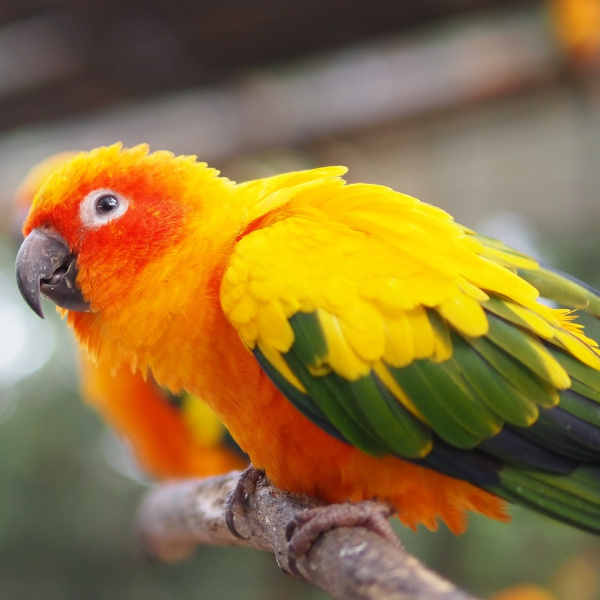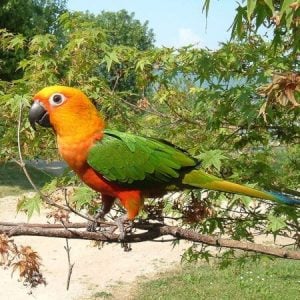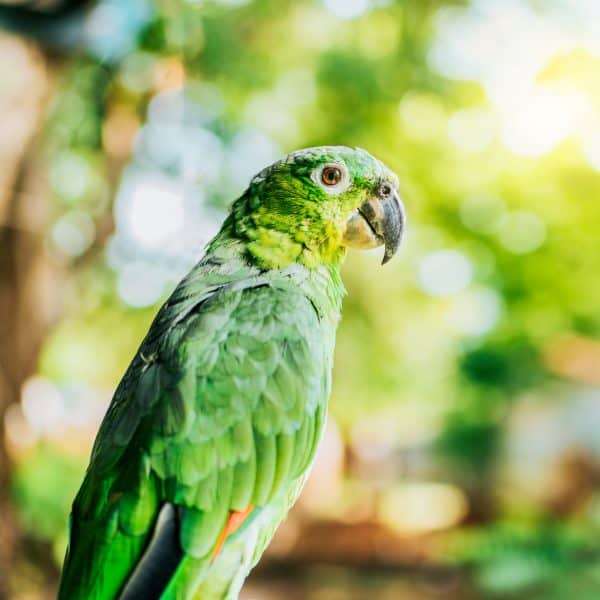
I Took In A Rescue Sun Conure That’s Biting Me – Help!
Last Updated on by Mitch Rezman
Mimi H writes,
A patient of mine highly recommended you. I’ve watched some of the biting videos but you see I took in a rescue sun conure. We believe it’s male. It humps everything right now.
His wings are not clipped mind you and I’m not against doing it if it will help.
My issue is not only is he hand shy but also a biter really bad.
We believe he is 4-5yo.
Where should I start and how?
Should I have wings clipped and teach him to step up with a finger or a small perch?
Would I have more control with wings clipped?
Any advice would be much appreciated.
Sincerely a very frustrated Mimi
Hi Mimi,
Deep breaths grasshopper and just because it humps everything, doesn’t mean it’s a boy:-)
The first place to start is with clicker training.
This is how we get the birds to respond to positive reinforcement here are a bunch of how-to videos on clicker training.
https://windycityparrot.com/blog/2016/11/09/clicker-training-videos/
It’s always best to determine the sex of a bird which helps provide insight to its behavior.
A bird that doesn’t lay an egg is not necessarily a male.
Brooding birds will exhibit some different activities than males.
Clipping your birds wings doesn’t solve anything.
A bird with clipped wings also has a far lesser sense of balance and is more prone to fall off perches especially at night.
There’s no relationship that I found between the 50% of flight feathers remaining at a birds brain.
The only time a bird really knows when is clipped is when he/she goes to preen and gets all those rough edges left by the scissors.
A flighted bird will be a happier healthier bird that is able to burn calories reducing bad hormonal activity.
It’s important offer lots of forging opportunities and remove any brooding signals like nest boxes, birdcage huts, blankets on furniture or anything that can be construed as a dark place it’s good to have babies.
best
Mitchr
Description: Sun Conures measure 12 inches (30cm) in length, including the long tail. They weigh between 3.5 – 4.5 oz (100 – 130g), with an average weight of 4 oz (110 g.)
Green cheek conures average weight is about 70 g – but the general weight range of this species is between 60 to 80 grams. The average length (including tail) is 10 – 11 inches (25 -27 cm).
In my role as an advocate for captive birds I like to remind people that there are far more Conures than sons and green cheek’s.
We get in many inquiries on a regular basis starting with I have a con year. What surprises most people are that there are approximately 120 species of Conures List of types of Conure parrot species
What surprises even more people is a range of Conures sizes. Whereas green cheek’s are about 70 g and about 11 inches long, Patagonian conures
I’m waiting for my nanday conure to she me she’s ready for training
I’m sorry, expecting a bird to set its own training pace is makes no sense which would be the case with training any animal.
What criteria would the bird use to structure training sessions?
If you’re committed to training you set the time of day for training the animal be it a bird, a dog or a horse.
The animal will expect and look forward to training time which is also one-on-one bonding time.
Birds especially like routines, they know the precise time of day.
So here’s where you going to have to take a step backwards and clip your bird’s wings.
That solves the flying away problem.
If your bird won’t step up to your hand try offering a simple round wood dowel perch as your first step.
It might not be as scary as your hand.
You can also try to install a grooming perch inside the cage door if it’s wide enough.
This acts as a compromise so the bird can come out of the cage but still be on the cage while trimming its nails doing little happy dance on the perch.
See if your bird will step up on your hand from the installed grooming perch
This would be a good time to introduce clicker training.
Target-click-reward
You can use sunflower seeds if you like but for training purposes it should be the kernel only raw and unsalted.
Sunflowers in the shell take too long for the bird to chew up after being rewarded for positive action.
You’re not preparing your bird to not only step up but prepare for flight.
This is where when your bird is relearning how to fly you take the time to not teach them how to fly but how to and where to land.
Clicker training is your bridge from step up to flight recall which is extraordinarily rewarding.
You must be patient and consistent.
The process never ends because you can always get your bird to do more things.
Author Profile
Latest entries
 The Traveling BirdJune 26, 2025Can You Name 5 Parrot Species That Are Living Wild in the USA?
The Traveling BirdJune 26, 2025Can You Name 5 Parrot Species That Are Living Wild in the USA? Bird BehaviorJune 26, 2025How is it Parrots Are Problem Solvers Social Animals and Even Use Tools?
Bird BehaviorJune 26, 2025How is it Parrots Are Problem Solvers Social Animals and Even Use Tools? Bird & Parrot AnatomyJune 25, 2025How a Tiny Chemical Modification Makes Parrots Nature’s Living Paintings
Bird & Parrot AnatomyJune 25, 2025How a Tiny Chemical Modification Makes Parrots Nature’s Living Paintings PigeonsJune 20, 2025How Do Parrots Thrive in Cities Outside Their Native Habitats?
PigeonsJune 20, 2025How Do Parrots Thrive in Cities Outside Their Native Habitats?


